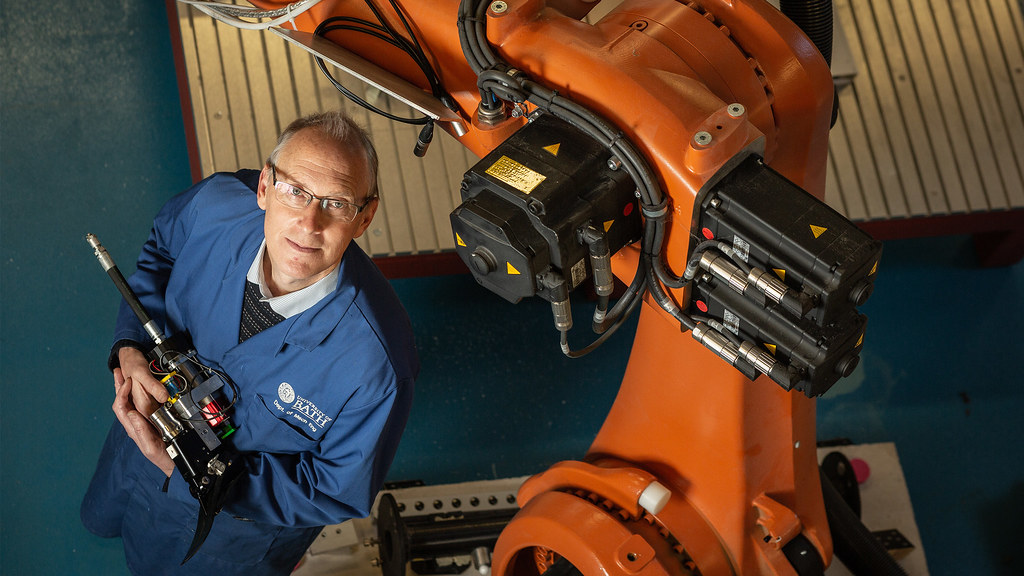Additive manufacturing (AM) is revolutionising the way we realise new (and old) products. Similar to standard 3D printing but on an industrial scale, AM can create complex bespoke parts with very little wastage.
Its ability to facilitate rapid prototyping is changing the design process to a fast, digital, highly dynamic activity. Designs can be quickly altered on computers while products are manufactured on factory production lines below. The result is reduced costs and lead times, and in many cases, parts that have better strength and reliability.
Machines to imagine new designs
Additive manufacturing machines translate computer designs from a digital file into physical 3D objects. With traditional techniques such as forging and casting unable to achieve the same level of precision, designs are often being realised for the first time as a single object.
Our approach is to use precisely controlled laser melting, which fuses metallic powders together using a high-power-density laser, forming complex shapes a layer at a time. The result is a solid, strong metal part.
Using these highly specialised machines, we can offer designers creative freedom like never before to experiment with product form and function. The RenAM 500M is part of this new generation of machines. Working with Renishaw, our research has helped inform the development of this new AM platform that is the basis of the company's future additive manufacturing systems product range. It features automated powder and waste handling systems resulting in a consistent process quality and enhanced safety. This means better parts for the aerospace industry.
Improving aircraft components
Moog Inc is a major global designer and manufacturer, and the world's largest producer of precision hydraulic control valves (servovalves) for the aerospace industry. We've been working with Moog for over 15 years on research projects to investigate new concepts and improve their manufacturing processes.
Servovalves play an important part in controlling the flight of an aircraft as they determine the flow of hydraulic fluid sent to move aerodynamic surfaces. Moog wanted to reduce the weight and part count for these safety-critical components. We believed additive manufacture was the best way to realise an improved product design, so we introduced Moog to our industrial partner and maker of AM machines: Renishaw.
Together we investigated the correlation of microstructure and fatigue performance with manufacturing process parameters. We found that with appropriate process parameters and heat treatment, we could save weight while maintaining acceptable fatigue life. We could also reduce material waste and the number of parts such as seals, screws and plugs. The result is a lighter and more reliable part, printed on Renishaw machines.
After seeing the success of using additive manufacturing for the new servovalve, Moog invested £30 million in AM including two dedicated centres for development and manufacturing. With Moog’s new additive manufacture capability and understanding of how to design optimised hydraulic components, we saw an opportunity for a strategic partnership between Moog and our powered prosthetics research partners: Blatchford.
Developing powered prosthetics
Since 1890 Blatchford have been designing and manufacturing prosthetics. They have a long history of innovation, including the first commercially available hydraulic prosthetic ankle, and have received a host of awards along the way. For nearly 10 years they have supported research into smart powered prosthetics here at Bath, using our long-standing expertise in hydraulic actuation, dynamics and control.
Working alongside Moog we set out to bring our powered prosthetics research to the commercial market. Moog's AM manufacturing facilities allowed us to produce parts at a reduced size and weight, creating a powered prosthetic ankle that is both durable and more comfortable to use for amputees.
The integrated hydraulic actuation gives the prosthesis the equivalent of muscle power, enabling faster level walking and much easier ascent of slopes and stairs. This is a big advance compared to standard commercial prosthetic ankles.
Driving business growth
Our research in the area of additive manufacturing has produced new AM design rules, methods and post-processing strategies. It has improved our understanding of material properties, microstructure, and fatigue performance.
Our work with Renishaw has helped to realise new industrial and healthcare applications for selective laser melting with significant benefits for end users and patients.
We’ve helped influence a new strategy at both Moog and Blatchford with a focus on AM products and devices. Moog's two dedicated AM centres grow from strength to strength, and their AM products are already making an impact in the marketplace, starting with an integrated robot actuator in 2017.

